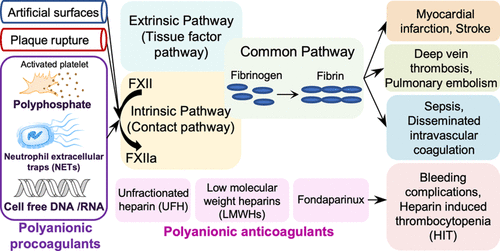当前位置:
X-MOL 学术
›
Biomacromolecules
›
论文详情
Our official English website, www.x-mol.net, welcomes your
feedback! (Note: you will need to create a separate account there.)
Targeting Biological Polyanions in Blood: Strategies toward the Design of Therapeutics.
Biomacromolecules ( IF 5.5 ) Pub Date : 2020-06-04 , DOI: 10.1021/acs.biomac.0c00654 Chanel C. La , Lily E. Takeuchi , Srinivas Abbina , Sreeparna Vappala , Usama Abbasi , Jayachandran N. Kizhakkedathu
Biomacromolecules ( IF 5.5 ) Pub Date : 2020-06-04 , DOI: 10.1021/acs.biomac.0c00654 Chanel C. La , Lily E. Takeuchi , Srinivas Abbina , Sreeparna Vappala , Usama Abbasi , Jayachandran N. Kizhakkedathu

|
In this Review, we highlight well-described and emerging polyanions, and the way these molecules can be targeted in the design of potential therapeutics (synthetic and biologics) with applications in thrombosis and hemostasis. It is important to strike a balance between bleeding and clotting. In thrombosis, unwanted blood clots are formed in the lumen of a blood vessel, obstructing the flow of blood through the circulatory system. Over many years of research, several polyanionic biopolymers that can either impede (anticoagulant) or promote (procoagulant) blood clotting have been identified. Mediators impeding blood clotting, including polyanionic polysaccharides such as heparins and heparin mimics, are widely used as antithrombotics, although they impart adverse complications such as bleeding. Emerging synthetic polycations and well-described cationic proteins that are specifically designed to neutralize the biological activity of heparins to prevent bleeding complications are discussed. On the other hand, there is growing evidence that several polyanions bear a procoagulant nature in blood; polyphosphate (polyP), neutrophil extracellular traps (NETs), extracellular RNA, and cell-free DNA are shown to promote blood clotting. Recent research highlights the use of polycations and enzymes that either inhibit or cleave these procoagulant polyanions and demonstrates the proof-of-concept design of new antithrombotics without bleeding side effects. Additional studies have shown that some of these procoagulant polyanions can be used as a hemostat to prevent bleeding in an emergency. There are significant opportunities for chemists in the design of new inhibitors and agents with improved selectivity toward these biological polyanions, furthering the development of novel therapeutics.
中文翻译:

针对血液中的生物聚阴离子:针对治疗药物设计的策略。
在这篇综述中,我们重点介绍了描述良好的和新兴的聚阴离子,以及这些分子在靶向血栓形成和止血中的潜在治疗剂(合成和生物制剂)设计中的靶向方式。重要的是要在出血和凝结之间取得平衡。在血栓形成中,不需要的血凝块在血管内腔中形成,阻碍了血液通过循环系统的流动。在多年的研究中,已经发现了几种可以阻碍(抗凝)或促进(促凝)凝血的聚阴离子生物聚合物。阻碍血液凝结的药物,包括聚阴离子多糖(例如肝素和肝素模拟物),尽管会带来不利的并发症(例如出血),但被广泛用作抗血栓药。讨论了专门设计用于中和肝素的生物活性以防止出血并发症的新兴合成聚阳离子和众所周知的阳离子蛋白。另一方面,越来越多的证据表明,几种聚阴离子在血液中具有促凝性。聚磷酸盐(polyP),嗜中性粒细胞细胞外捕获物(NETs),细胞外RNA和无细胞DNA可以促进血液凝结。最近的研究重点介绍了可抑制或裂解这些促凝血聚阴离子的聚阳离子和酶的使用,并证明了新的抗血栓药的概念验证设计无出血副作用。进一步的研究表明,这些促凝聚阴离子中的某些可以用作止血剂,以防止紧急情况下的出血。
更新日期:2020-07-13
中文翻译:

针对血液中的生物聚阴离子:针对治疗药物设计的策略。
在这篇综述中,我们重点介绍了描述良好的和新兴的聚阴离子,以及这些分子在靶向血栓形成和止血中的潜在治疗剂(合成和生物制剂)设计中的靶向方式。重要的是要在出血和凝结之间取得平衡。在血栓形成中,不需要的血凝块在血管内腔中形成,阻碍了血液通过循环系统的流动。在多年的研究中,已经发现了几种可以阻碍(抗凝)或促进(促凝)凝血的聚阴离子生物聚合物。阻碍血液凝结的药物,包括聚阴离子多糖(例如肝素和肝素模拟物),尽管会带来不利的并发症(例如出血),但被广泛用作抗血栓药。讨论了专门设计用于中和肝素的生物活性以防止出血并发症的新兴合成聚阳离子和众所周知的阳离子蛋白。另一方面,越来越多的证据表明,几种聚阴离子在血液中具有促凝性。聚磷酸盐(polyP),嗜中性粒细胞细胞外捕获物(NETs),细胞外RNA和无细胞DNA可以促进血液凝结。最近的研究重点介绍了可抑制或裂解这些促凝血聚阴离子的聚阳离子和酶的使用,并证明了新的抗血栓药的概念验证设计无出血副作用。进一步的研究表明,这些促凝聚阴离子中的某些可以用作止血剂,以防止紧急情况下的出血。











































 京公网安备 11010802027423号
京公网安备 11010802027423号